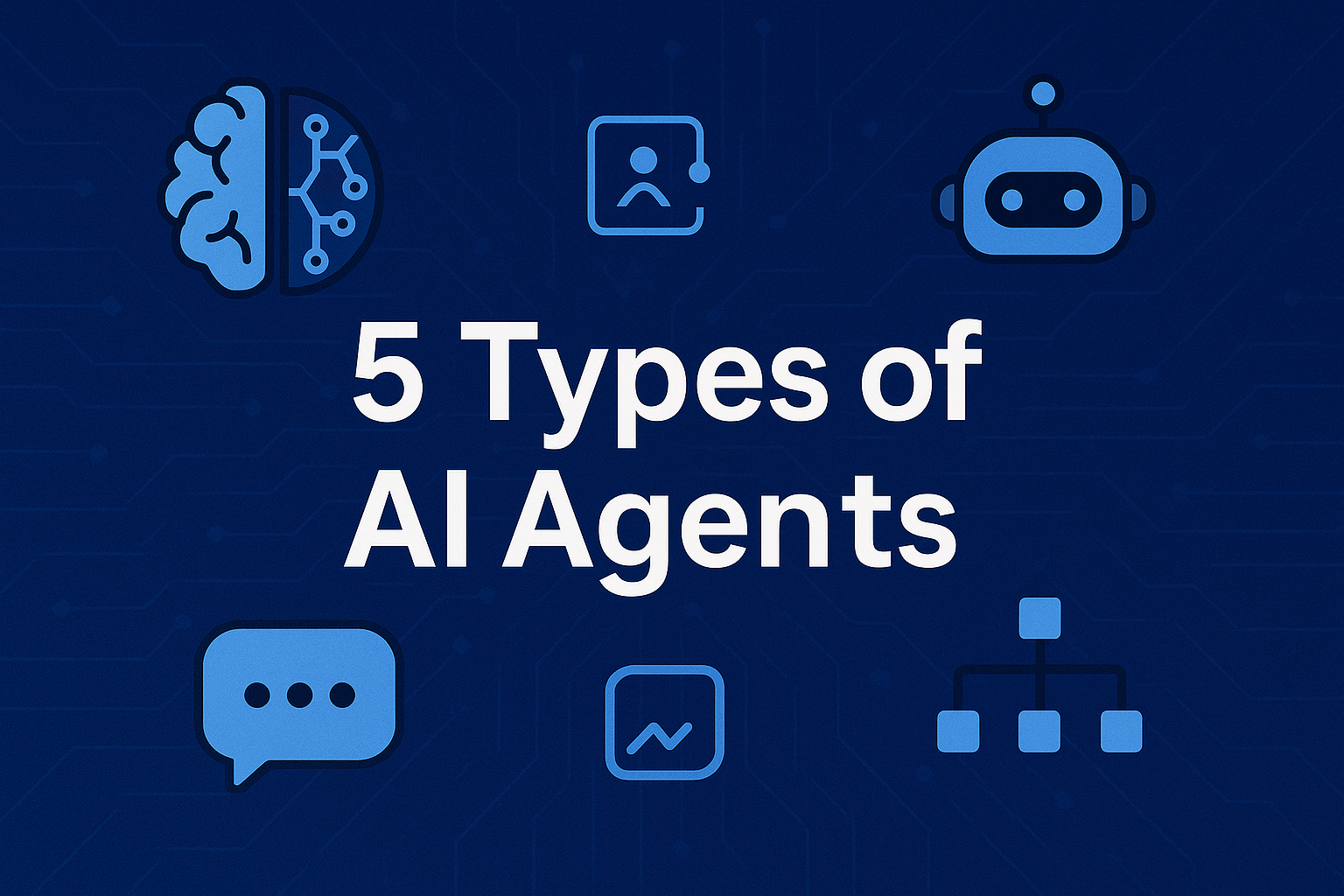Types of AI Agents: Artificial Intelligence (AI) is rapidly evolving, and if there’s one trend dominating 2025, it’s the rise of AI agents. Across industries, new agent-based systems are being deployed to automate complex tasks—once reserved for human expertise. From smart assistants to autonomous drones, these agents are redefining productivity and efficiency.
But to truly understand how AI agents can help you or your business grow, it’s important to distinguish between the different types of AI agents—each with its own intelligence model, capabilities, and limitations.
In this guide, we’ll explore the five primary types of AI agents, from simple rule-followers to sophisticated learning models—and explain how they can be applied to real-world problems.
1. Simple Reflex Agents – Fast but Rigid
The most basic type of AI agent is the simple reflex agent. It works by reacting to specific inputs using a set of predefined rules—without any sense of history or memory. Think of a thermostat: it turns the heat on when the room temperature drops below a certain level and turns it off when a desired temperature is reached.
How it works:
- The agent receives input from the environment through sensors.
- This input is evaluated using condition-action rules.
- Based on the rule (e.g., If temperature < 18°C, then turn on heater), the actuator carries out an action.
- The action then influences the environment, triggering the cycle again.
Pros:
- Simple and fast to execute.
- Ideal for stable and predictable environments.
Cons:
- No memory or learning ability.
- Cannot handle dynamic or unfamiliar scenarios.
2. Model-Based Reflex Agents – Reactive with Memory
The model-based reflex agent takes things a step further by incorporating a memory of the environment. In addition to using condition-action rules, it maintains an internal model of the world to track how actions affect the environment over time.
A perfect example is a robot vacuum cleaner. Unlike a simple reflex system, it remembers which areas it has already cleaned and where obstacles exist. If it moves forward and bumps into a wall, that information is stored in its internal state, helping it navigate more efficiently in the future.
Key features:
- Stores internal state (memory).
- Tracks environmental changes and agent actions.
- Makes decisions based on both current inputs and past experiences.
This type of agent is suitable for environments that require a bit more reasoning without the need for advanced planning.
3. Goal-Based Agents – Driven by Purpose
Goal-based agents introduce a more intelligent decision-making mechanism. Instead of reacting to conditions, they operate with a specific goal in mind. These agents simulate the consequences of various actions to identify which one best achieves their objective.
Take a self-driving car as an example. If its goal is to reach a destination, it evaluates different route options and selects the one that brings it closer to that goal. It doesn’t just respond to road conditions—it strategizes.
Advantages:
- Able to plan ahead.
- More flexible and adaptive in complex scenarios.
Use cases:
- Robotics, navigation, gaming, and simulations where goal-directed behavior is essential.
4. Utility-Based Agents – Making Smart Trade-offs
While goal-based agents aim to achieve a target, utility-based agents go a step further by choosing the most desirable outcome among multiple options. These agents evaluate each possible result based on a utility function, which measures factors like speed, cost, energy efficiency, or user satisfaction.
For instance, an autonomous drone delivery system could choose among several delivery routes. A goal-based agent might simply pick any route that gets the package delivered. But a utility-based agent would analyze each route based on time, weather, battery usage, and risk, and then pick the one that maximizes overall utility.
Key traits:
- Makes trade-offs between conflicting goals.
- Requires a well-defined utility metric.
- Produces optimized outcomes.
This type of agent is excellent for decision-making systems in finance, logistics, and multi-variable planning.
5. Learning Agents – Evolving Through Experience
The learning agent is the most advanced and adaptable type. Rather than being hardcoded with fixed behaviors, it learns from experience using feedback from its environment. This is the foundation of reinforcement learning, a technique where agents improve performance by trial and error.
Components of a learning agent:
- Performance Element: Executes actions based on current knowledge.
- Learning Element: Updates knowledge using feedback.
- Critic: Evaluates actions and provides a reward signal.
- Problem Generator: Suggests new actions to explore and improve.
A great example is an AI chess bot. It plays games (performance), observes outcomes (critic), adjusts strategies (learning), and tries new moves (problem generator). Over time, it becomes stronger by learning what works and what doesn’t.
Benefits:
- Self-improving over time.
- Highly adaptable to new environments.
- Ideal for complex and data-rich systems.

